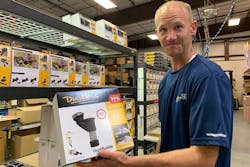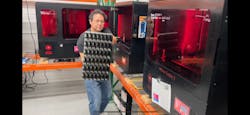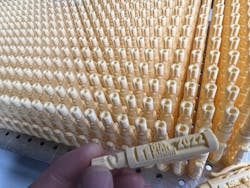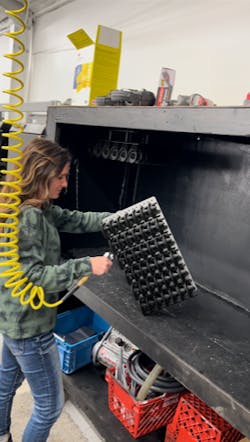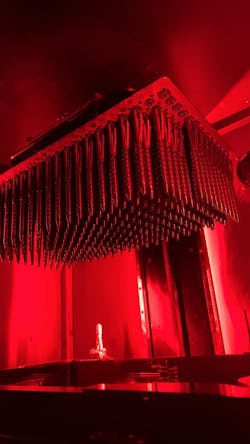3D printing helps vacuum manufacturer evolve
By Karen Hanna
New manufacturing processes that eliminate the need for expensive tooling and provide freedom to make changes on the fly present opportunities to simplify supply chains and react quickly to crisis. For a rural Utah county anticipating job loss and witnessing population decline, additive manufacturing also could provide a lifeline, according to one plastic parts company CEO, who’s charting a new vision for his mining community.
Spencer Loveless, who heads up the Dustless Technologies vacuum-machine company, credits an evolution from injection molding to 3D printing for the growth of the company his parents started in Price, Utah, as well as the birth of a contract printing lab next door. Between the two companies, about 50 employees are making products once sourced from overseas.
Related: Supply chain challenges point up advantages of reshoring
“It’s cool because these jobs, the jobs are [coming] back to America in a tech aspect. If we’re going to compete with these overseas countries in their game, we’re not going to win. And injection molding is typically their game, and so our take is if we’re going to beat them, we’re going to use technology to beat them,” Loveless said. “Because even if they’re doing 3D printing overseas, they’re not going to be able to compete on a one- to two-week lead time.”
In his LinkedIn profile, he sums up his philosophy with the tag line: “Bringing jobs back to rural America through Additive Manufacturing. … Just print it!” He sees 3D printing as a growth opportunity for both his companies and the local community, where the coal industry has long been the bedrock of the economy.
“They are a large portion of the jobs in the area,” Loveless said.
For his part, he’s moving away from outsourcing injection molding — a process Dustless Technologies has used for decades to build vacuums, starting with its first model, invented by his father.
A boon to small businesses
“There’s not very many companies, including ourselves, that [have] a million-dollar budget, just to say, ‘Yes, I think this is a good idea, and I’m going to spend a million dollars on molds,’ ” Loveless said. “But in the same breath, if they could say, ‘But I would 3D print it because then I can be agile, and I don’t have molds and I can test the market first, before I really pull the trigger on more parts,’ then it levels the playing field for some of the smaller manufacturers, because they don’t have the budgets that the big-pocket manufacturers do.”
To keep costs down, the company has regularly bought molds and tooling from China, and contracted for parts to be injection molded there. It’s also relied on traditional manufacturing methods, including stamping and casting processes.
But the approach meant Dustless Technologies couldn’t make changes or launch new products quickly. It was tedious, Loveless said.
Then, the COVID-19 pandemic struck.
“We actually had a 1- and 2-dollar part that [was] stuck on containers out in theMerit3D — a separate company that 3D prints parts for both Dustless Technologies and other companies — was born. In the last couple years, it’s continued to grow, with vacuum parts for Dustless Technologies, along with items such as promotional pens, wall-stud finders and phone cases for other companies.
The new capabilities have allowed Loveless to employ more people — 15 have been added in the last couple years.
“It’s just the start of a beautiful, beautiful adventure,” he said.
Of the parts used in Dustless Technologies products, the percentage of components made in China continues to go down; Loveless estimated that 60 percent are made overseas now compared with 75 percent in the pre-3D printing times. Ultimately, he would like to 3D print — rather than injection mold — all the parts.
“It’s not like a turn-off-the-faucet-and-turn-on-this-other-faucet thing. It’s just an evolution that the company [has] that the different methods and ways that you can produce a part and the agility that you can have with 3D printing. You can change your design whenever you want, which, with traditional manufacturing, you can’t,” he said.
Signs of the times
The evolution of Dustless Technologies parts, along with the development of Merit3D, come at a time when supply chain experts say companies have had to rethink their supply chains and processes.
“To adapt, companies have to be both resilient and agile,” supply chain consultant Gary Smith said. “Resiliency is the ability to absorb the shock, or the change. Then, an organization must be agile, which means that they must be able to pivot and move in a new direction.”
Reshoring work, as Dustless Technologies has done, will require technologies, including automation, said Harry Moser, founder and president of the Reshoring Initiative, a nonprofit dedicated to made-in-America manufacturing jobs.
“The tendency is to bring them back with a more advanced manufacturing methodology,” Moser said.
Merit3D uses a variety of printers, but works closely with Photocentric Inc., Avondale, Ariz. — a partnership that has led to the development of some ABS and nylon materials. The 3D printer OEM’s LC Magna is “a printer that we can print tens of thousands of parts per day,” Loveless said.
To illustrate the flexibility of 3D printing, Loveless has coined a term — “proto-duction” — that he says explains his companies’ approach. Prototyping and production no longer have to be separate steps.
3D printing technologies now allow seamless transition from product design to launch through evolution and upgrades.
“When Home Depot says, ‘I need 10,000 parts,’ then you have to be able to deliver 10,000 parts pretty quickly, and you can’t wait months and months for those parts to be made,” Loveless said.
Overcoming labor issues
In addition to the printers, employees are using three robots from Universal Robots, Boston. Loveless is partial to Universal Robots because its equipment is easy to program.
“So, we don’t need robot technicians. You can take someone on the plant floor, and you can train them how to run these, and then at that same breath, you can give them a raise as well, because now you can train them to be a robot tech,” he said.
Finding employees with the appropriate backgrounds isn’t easy, so the companies are working with area schools, colleges and the state of Utah to train the workers they need. The companies’ workforce includes college and high school interns. Special emphasis is on people from disadvantaged backgrounds, such as those battling addictions, single moms and out-of-work miners, Loveless said.
An apprenticeship program also is in the works.
“We can train them to be able to be a 3D designer. …. We have quite a few programs that we’re working on and are working with other companies to put in place ... because … the worker pool is very scarce. But if you can take someone at a lower level and train them up, then your worker pool becomes a lot greater if you have those training elements in place,” Loveless said.
He already is looking ahead to a time when more miners in the area will be out of work, once the power plants that run on the coal they extract are shuttered.
When the plants close in the coming decades, he wants to be ready for it.
“It’s our mission; our mission is to create 1,700 jobs in rural Carbon County, Utah, because that’s how many jobs are going to be lost when the coal plants shut down,” he said.
Karen Hanna, senior staff reporter
About the Author
Karen Hanna
Senior Staff Reporter
Senior Staff Reporter Karen Hanna covers injection molding, molds and tooling, processors, workforce and other topics, and writes features including In Other Words and Problem Solved for Plastics Machinery & Manufacturing, Plastics Recycling and The Journal of Blow Molding. She has more than 15 years of experience in daily and magazine journalism.
